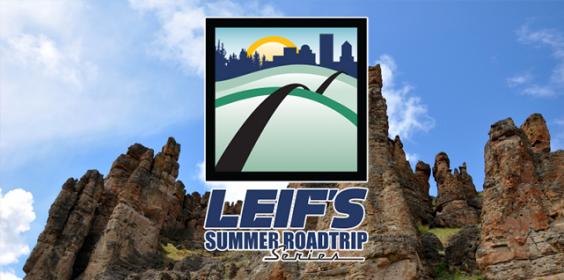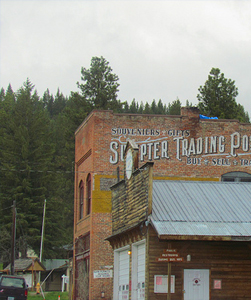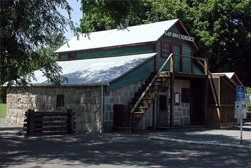An Alpine Lake, a Ghost Town, and More- Discovering Oregon’s Gold Rush Past in the Elkhorn Mountains

When it gets into August in Portland, you’re probably looking for a new road trip idea that isn’t the familiar Oregon Coast. A circle out to little-known Anthony Lake, Sumpter, the gold country, and John Day’s uniquely preserved Kam Wah Chung Historic Site may be just what you need for a memorable getaway that truly showcases another side of Oregon.
About Leif’s Summer Roadtrip Series
This summer we will publish a series of articles that combine two of my greatest passions; cars and the Pacific Northwest.
Should you decide to try one or a few of the overnight trips we’ll present, you and your travel companions will enjoy The Area’s less widely known but truly iconic scenery and experiences en route to your destination.
If you find these articles valuable or have suggestions for new ideas or improvements, we would love to hear from you. Please email us at webmail@leifs.com.
– Leif
Begin your road trip heading eastbound on Interstate 84. Halfway between La Grande and Baker City, you’ll turn off the interstate at the small community of North Powder. Named for the swift-flowing Powder River, a tributary of the Idaho’s Snake River, North Powder originally prospered due to an icehouse that supplied the refrigerator cars of the Pacific Fruit Express Railroad until the 1930’s. Now, the population lies at less than 500 and North Powder has a new role as a gateway for attractions within the Blue Mountains and the Wallowa-Whitman National Forest. The aptly-named Anthony Lakes Highway will take you from town 20 miles west to Anthony Lakes Mountain.
Anthony Lake: A Jewel of a Lake in Eastern Oregon’s Mountains
Anthony Lake at 22 acres is the largest of a group of lakes in the Anthony Lakes Recreation Area. Known for a world-class and uncrowded ski experience in the winter, summer brings an excellent chance to hike a network of mountain trails in an unspoiled wilderness. Views are picture-perfect with the rugged glacier-carved Elkhorn Mountains standing sentry over the shimmering blue waters of the lake. Dark green sub-alpine forests and meadows of wildflowers complete this serene scene. You’re at 7,100 feet here and if you’ve hoped to escape the heat of lower-lying areas, this is readily achieved. For fishermen and boaters, the lake is stocked with rainbow trout and native eastern brook trout are also present in the lake’s clear waters.
Elkhorn Scenic Byway and Granite: Craggy Mountain Peaks Stand Sentry Over a Still-Living Ghost Town
The 106-mile Elkhorn Byway journeys through the lake and river-filled Elkhorn range peaks, but also to gold-mining ghost towns and other hidden pieces of Oregon that are well off the beaten path. Leaving Anthony Lake, you’ll take the byway west and begin to follow the North Fork of the Wild and scenic John Day River to an intersection with Forest Road 73 at the town of Granite.
Once a boomtown with legendary characters named Skedaddle Smith, One-eyed Dick, and ’49 Jimmie, gold was discovered nearby in 1862 and Granite boomed for about 80 years to a population high of 5,000. Today, this is Oregon’s fourth smallest town with some original buildings remaining along with 38 souls and a small restaurant/general store.
Sumpter: Relive the Gold Rush Days with a Train Ride and More

A few more miles down the road, Sumpter is home to two attractions, the meticulously recreated narrow gauge ‘Stump Dodger’ Railroad as well as 2.4 million pound Gold Dredge #3 with its easily recognized path of tailings behind. In its heyday, Sumpter’s miners produced over $10 million in gold ore and the town had 15 saloons, 3 newspapers, and an opera house. The original business district was destroyed by fire in 1917, but gold continued to be extracted from the area until 1954 with three dredges. Dredge #3 was the last used, having been constructed partially from the remains of the first dredge once it went idle, and it is one of the country’s largest and most accessible dredges. Between 1935 and 1954, the dredges traveled a total of 8 miles at a rate of over 20 buckets (7 yards of earth) per minute, and required a round-the-clock crew of 3 men to operate the machinery and 17 other workers. Oregon State Parks maintains an excellent visitor’s center where one can pan gold as well as tour the dredge itself.
The Sumpter Valley Railway is unique in that most tourist railroads operate within an abandoned right of way, often using largely original tracks and structures. The 6 miles between Sumpter and McEwen follows the original route of the Sumpter Valley Railway, yet the original track was long ago scrapped in 1947 and the roadbed severely eroded. In order to operate this tourist ride, the entire railway has been rebuilt and many train cars have been restored by interested volunteers. The train runs several times daily on weekends throughout the summer and into the fall.
From Sumpter, head a short distance southeast until the intersection with state Highway 7. You’ll then make a turn to the west to loop back towards Portland. After passing over a series of summits (Larch Summit, Blue Mountain Summit, and Dixie Summit), you’ll join with Highway 26 and soon find yourself in the community of Prairie City. Take a moment to walk the main street for a quintessential slice of ‘small town America’, visiting the old fashioned general store, a true western wear outfitter, and perhaps the big game museum.
Kam Wah Chung: A Rare Look into a Preserved Piece of the Past

Next up along the road is John Day, a gateway community for both the Fossil Beds to the west, and the Kam Wah Chung State Heritage Site. If you’ve never been, Kam Wah Chung is a ‘must see’ for its unique glimpse into the past and invaluable collection of artifacts seen nowhere else. Originally a general store and herbal medicine clinic, as well as a social gathering spot and dormitory for the Chinese community, after 50 prosperous years the doors were literally shuttered one day with thousands of products still on the shelf. The building sat forgotten until the town was surveying for a new park and found documentation that the building had been deeded to the city for use as a museum.
To return to Portland, you could continue on Highway 26 into Prineville and from there take Highway 20 to Eugene or perhaps continue on 26 past Maupin and the back side of Mt. Hood. However, the quickest way home is probably going to be a quick jog west to Mt. Vernon then a turn to drive north on 395 to connect with I-84 in Pendleton, a route that takes you through a peacefully remote stretch of the state. A stop at Ritter Butte affords a chance to climb a lookout tower and a short detour into the town of Ritter offers a secluded hot springs. You’ll then pass through two state scenic corridors before coming upon the formation of Pilot Rock rising out of the flatlands. From here, it’s only 15 more miles to Pendleton and the interstate to home, where you’ll soon realize how diverse the land and people of Oregon can be.
Learn More:
Anthony Lakes Recreation Area
Elkhorn Scenic Byway
Granite
Sumpter
Gold Dredge #3
Sumpter Valley Railroad
Prairie City
John Day
Kam Wah Chung








